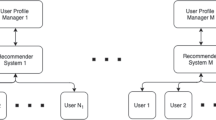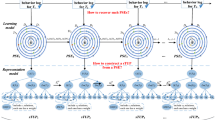Abstract
User profiling represents an important initial step in personalizing web services and in building recommendation systems. Non-invasive profiling methods monitor users’ behavior and infer interest profiles from their past actions. Most existing profiling methods, which relate the users’ interests to a given ontology, consider only the user’s past actions when calculating his/her profile. The profiling algorithms use a time-decay function for users’ past actions to adapt the profile to shifts in the user’s interests over time. In our work, we propose a hybrid method that combines time-decay and profile correction using prototype profiles. The additional profile correction step considers the interests of similar users and expands the interest scores beyond the concepts detected in the user’s past actions, which facilitates faster profile adaptation to the user’s new interests. In our experimental work, we experimented extensively with two real data sets: data of an online advertising network and student data in an online e-learning environment. We measured the quality of the computed user profiles by correlating them to users’ future actions. Experiments revealed that it is crucial to build the user’s profile using a large number of events from his/her past and to update the profile regularly. When we are unable to do so, the profile correction can be used to keep the quality of the profile from dropping too low. The results show that our method significantly outperforms existing ontological profiling methods.















Similar content being viewed by others
Explore related subjects
Discover the latest articles, news and stories from top researchers in related subjects.References
Beitzel S M, Jensen E C, Chowdhury A, Grossman D, Frieder O (2004) Hourly analysis of a very large topically categorized web query log. In: SIGIR ’04 Proceedings of the 27th annual international ACM SIGIR conference on Research and development in information retrieval, 321–328
Billsus D, Pazzani M J (2000) User modeling for adaptive news access. User Model User-Adap 10:147–180
Cremonesi P, Koren Y, Turrin R (2010) Performance of recommender algorithms on top-n recommendation tasks. In: Proceedings of the fourth ACM conference on Recommender systems, 39– 46
Daoud M, Tamine-Lechani L, Boughanem M (2009) Towards a graph-based user profile modeling for a session-based personalized search. Knowl Inf Syst 21 (3):365–398
Davies D L, Bouldin D W (1979) A Cluster Separation Measure. IEEE T. Pattern Anal 1 (2):224–227
Davoodi E, Kianmehr K, Afsharchi M (2013) A semantic social network-based expert recommender system. Appl Intell 39 (1):1–13
The Open Directory Project. Available at: http://www.dmoz.org/
Dunn J C (1973) A fuzzy relative of the ISODATA process and its use in detecting compact well-separated clusters. J Cybern 3 (3):32–57
Eyharabide V, Amandi A (2012) Ontology-based user profile learning. Appl Intell 36 (4):857–69
European Parliament Council: Directive 2009/140/EC of the European Parliament and of the Council of 25 November 2009 amending Directives 2002/21/EC on a common regulatory framework for electronic communications networks and services, 2002/19/EC on access to, and interconnection of, electronic communications networks and associated facilities, and 2002/20/EC on the authorisation of electronic communications networks and services (Text with EEA relevance). Available at: http://eur-lex.europa.eu/LexUriServ/LexUriServ.do?uri=CELEX:32009L0140:en:NOT
Fisher D H (1987) Knowledge acquisition via incremental conceptual clustering. Mach Learn 2 (2):139– 172
Ganesan P, Garcia-Molina H, Widom J (2003) Exploiting hierarchical domain structure to compute similarity. ACM T Inform Syst 21 (1):64–93
Godoy D, Amand A (2007) Modeling user interests by conceptual clustering. Inform Syst 31 (4–5):247–265
Godoy D, Amand A (2009) Interest drifts in user profiling: a relevance-based approach and analysis of scenarios. Comput J 52 (7):771–788
Junco R (2013) Comparing actual and self-reported measures of Facebook use. Comput Hum Behav 29:626–631
Koidl K, Conlan O, Wei L, Saxton A M (2011) Non-Invasive Browser Based User Modeling Towards Semantically Enhanced Personlization of the Open Web, WAINA ’11 Proceedings of the 2011 IEEE Workshops of International Conference on Advanced Information Networking and Applications, 35–40
Koren Y, Bell R, Volinsky C (2009) Matrix Factorization Techniques for Recommender Systems. Computer 42 (8):30– 37
Koychev I, Schwab I (2000) Adaptation to drifting user’s interests, proceedings of ECML2000 workshop: machine learning in new information age, 39–46
Kritikou Y, Demestichas P, Adamopoulou E, Demestichas K, Theologou M, Paradia M (2008) User Profile Modeling in the context of web-based learning management systems. J Netw Comput Appl 31 (4):603–627
Lee C S, Kao Y F, Kuo Y H, Wang M H (2007) Automated ontology construction for unstructured text documents. Data Knowl Eng 60 (3):547–566
Lloyd S P (1957) Least squares quantization in PCM. Bell Laboratories Paper
MacQueen J B (1967) Some Methods for classification and Analysis of Multivariate Observations. In: Proceedings of 5th Berkeley Symposium on Mathematical Statistics and Probability 1, 281–297
Middleton S E, Shadbolt N R, De Roure D C (2004) Ontological user profiling in recommender systems. ACM T Inform Syst 22 (1):54–88
Papadakis G, Niederée C, Nejdl W (2010) Decay-based ranking for social application content. In: WEBIST 2010, Proceedings of the 6th International Conference on Web Information Systems and Technologies 1, 276–281
Petrelli D, De Angeli A, Convertino G (1999) A User-Centered Approach to User Modeling. In: UM99 - User Modeling: Proceedings of the Seventh International Conference, 255–264
Serrano E, Such J M, Bota J A, Garca-Fornes A (2014) Strategies for avoiding preference profiling in agent-based e-commerce environments. Appl Intell 40 (1):127–142
Shie B E, Philip S Y, Tseng V S (2013) Mining interesting user behavior patterns in mobile commerce environments. Appl Intell 38 (3):418–435
Sieg A, Mobasher B, Burke R (2007) Learning ontology-based user profiles: a semantic approach to personalized web search. IEEE Intell Inform Bull 8 (1):7–18
Tan P N, Steinbach M, Kumar V (2005) Introduction to data mining. Addison-Wesley, Boston
Thomas E, Pan J Z, Taylor S, Ren Y, Jekjantuk N, Zhao Y (2010) Semantic advertising for web 3.0. Future internet symposium - FIS 2009. Lect Notes Comput Sci 6152 (/2010):96–105
Allan J (2004) HARD Track Overview in TREC 2003 - High Accuracy Retrieval from Documents. In: The Twelfth Text REtrieval Conference - TREC 2003, 24–37
Vivacqua A S, Oliveira J, De Souza J M (2009) i-prose: inferring user profiles in a scientific context. Comput J 52 (7):789– 798
Webb G I, Pazzani M J, Billsus D (2001) Machine learning for user modeling. User Model User-Adap 11 (1-2):19–29
Wilcoxon F (1945) Individual comparisons by ranking methods. Biom Bull 1 (6):80–83
Passani L. WURFL - Wireless Universal Resource File. Available at: http://wurfl.sourceforge.net/
Author information
Authors and Affiliations
Corresponding author
Additional information
Operation part financed by the European Union, European Social Fund.
Rights and permissions
About this article
Cite this article
Košir, D., Kononenko, I. & Bosnić, Z. Web user profiles with time-decay and prototyping. Appl Intell 41, 1081–1096 (2014). https://doi.org/10.1007/s10489-014-0570-9
Published:
Issue Date:
DOI: https://doi.org/10.1007/s10489-014-0570-9




